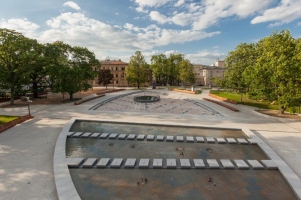Plac Litewski in Lublin for residents

Today, the president of Lublin, Krzysztof Żuk, will pass the modernized and expanded by Budimex Plac Litewski over to residents. The main attraction of the square will be the multimedia fountain park, entered in the Register of Historic Monuments at the beginning of the 1970 s.
The symbolic opening of the Plac Litewski will be combined with two evening multimedia shows specially prepared for the celebration of the 700th anniversary of conferring civic rights on Lublin.
Plac Litewski takes up approximately 35 thousand square meters. The main assumption of the revitalization was to stop vehicle traffic on the main traffic route of the city. The plan of the Square with two garden zones and a central part – an open central leisure space with a fountain – was retained. The central part of the square, in place of the old fountain, features an interactive system of water devices enabling to organize multimedia displays. Along the Krakowskie Przedmieście pedestrian walk, there are seven linear and one spiral fountain. The main part of the square was lined with granite slabs and blocks. The arrangement of green zones was also changed with new greenery islands.
Within this investment, Budimex replaced also all systems, erected a fence for a weather station, revived the areas adjacent to Plac Litewski, namely Plac Krąpca and Plac Czechowicza and relocated the Monument of the Unknown Soldier.
Works were carried out from April 2016. The value of the contract was PLN 42 million net.
Due to archeological works that accompanied the construction ones many relics of the past were discovered, related partially with the development of the city, but also to the time prior to its settlement. Remains of various residential and commercial buildings from the Middle Ages were discovered and many traces of production craft were identified. Archaeologists have also uncovered relics of ancient roads, and examples of pavements used in the past can be seen in the so-called Window of time - an underground chamber covered with a glass pane, which is located at the site of the discovery of historical roads.
